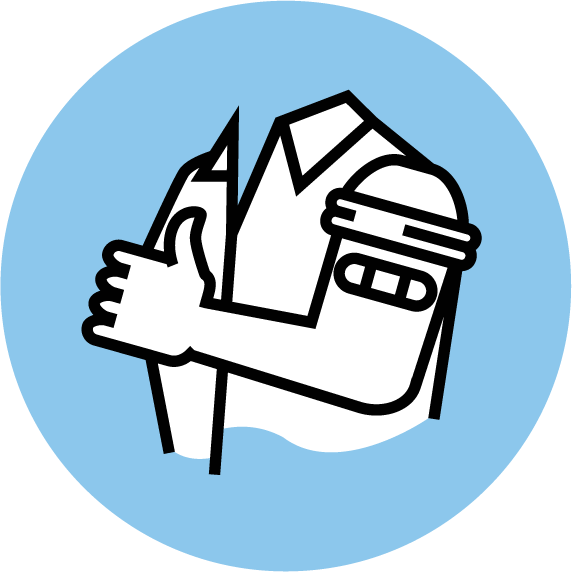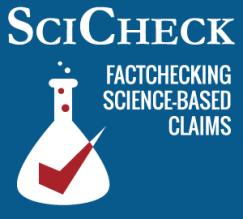No Surge in Athlete Deaths, Contrary to Widespread Anti-Vaccine Claims
SciCheck Digest
Sports medicine experts say there has been no increase in sudden death or cardiac injury among U.S. athletes since the COVID-19 vaccines became available. Yet anti-vaccine campaigners, comparing unreliable numbers to an unrelated study, have again spread a false narrative about vaccine safety since NFL player Damar Hamlin suffered cardiac arrest.

Full Story
For more than a year, anti-vaccine campaigners have been spreading the unfounded claim that athletes are in the grip of a health crisis — suggesting that COVID-19 vaccines have caused a surge in sudden deaths and injuries.

This baseless theory, which had been simmering in niche channels online, flooded social media after Buffalo Bills player Damar Hamlin, 24, collapsed during a game on Jan. 2 in front of millions of TV viewers. He has since been discharged from the hospital to recover at home. As we’ve explained, it’s not yet known why his heart stopped, but experts say Hamlin’s cardiac arrest was likely caused by an arrhythmia following a blow to his chest, called commotio cordis.
But prominent anti-vaccine influencers quickly posted claims on social media suggesting that the incident was somehow related to vaccination and part of a sinister trend.
For example, Ben Swann, who has spread misinformation about the pandemic since 2020, posted on Facebook on Jan. 3 an old video promoting the unsupported theory that there’s a recent surge in athlete deaths. The same day, conservative commentator Liz Wheeler and Dr. Simone Gold — who has peddled dubious cures for COVID-19, anti-vaccination messages and politicized medical misinformation — posted similar claims.
Gold wrote, in part, “I want to remind the public that athletes being incapacitated or dropping dead was not a ‘thing’ prior to 2020. We are now seeing this happen very frequently, and it’s extremely concerning.”
Both Wheeler and Gold cited a letter to the editor published in the Scandinavian Journal of Immunology that was co-authored by Dr. Peter McCullough, another prominent purveyor of COVID-19 misinformation. Although its publication may give the letter a veneer of legitimacy, the letter did not include any original research, as suggested by Fox News commentator Tucker Carlson. Rather, it relied upon an arbitrary list of athlete deaths maintained on an anonymous website that we wrote about shortly after it appeared online in late 2021.
As we explained before, the list includes students, professionals, amateurs, coaches and retirees. It includes people who died by suicide, car crash and drug overdose. The list does not — in nearly all cases — include the vaccination status of the deceased, let alone prove any causal relationship between vaccines and the deaths. In fact, as we’ve previously reported, some of the deaths initially listed happened before the vaccines had even become available to the age category for the person listed.
Wheeler and Gold, though, each shared an image that highlighted a portion of the letter comparing the number of deaths listed on the anonymous website with the number of sudden cardiac deaths among athletes that had appeared in academic literature over a 38-year period as compiled in a 2006 paper. The two figures reflect different criteria. One number is very broad and includes anyone with a passing relationship to sports who died for any reason since 2021, while the other is conspicuously narrow and includes only the deaths of athletes that were analyzed in English-language academic research papers.
Although the comparison they make is meaningless, Wheeler and Gold leave the false impression that there’s been a surge in deaths and further the baseless narrative that there’s been an increase in athlete injuries and deaths since the COVID-19 vaccines became available.
But the surge is fiction. It doesn’t exist.
Data Disprove Online Claims
“There is no uptick in sudden cardiac arrest or death in athletes due to COVID-19 or from COVID vaccinations. This is total misinformation,” Dr. Jonathan Drezner told us in an emailed statement. Drezner is the director of the UW Medicine Center for Sports Cardiology at the University of Washington, editor in chief of the British Journal of Sports Medicine, and a team physician for the Seattle Seahawks, the OL Reign soccer team and the University of Washington Huskies.
More than 2,000 children and adolescents in the U.S. die from sudden cardiac arrest every year, according to the Children’s Hospital of Philadelphia, and two-thirds of the deaths “occur during exercise or activity.” Among young athletes, sudden cardiac arrest is the leading cause of death, according to CHOP.
Drezner said his center monitors “all cases and all causes” of sudden cardiac arrest or death in athletes by working with the National Center for Catastrophic Sport Injury Research at the University of North Carolina at Chapel Hill. “[T]here is no change,” he said.
The National Center for Catastrophic Sport Injury Research catalogs injuries for high school and college athletes, and its most recent report covers the 2020-21 school year. It shows that 21 athletes died while playing their sport that year.
COVID-19 vaccines were available to everyone 16 and over in the U.S. by April 2021, so the overlap between the period covered by the report and the period in which vaccines were widely available to young people was relatively small. We reached out to the center to find out if the data collected for the 2021-2022 school year has indicated any increase in deaths.
The center’s director, Dr. Kristen Kucera, told us that so far, “the numbers are the same and it’s actually fewer than we captured in 2018-19.”
For context, the center reported 19 deaths in 2019-20, 25 deaths in 2018-19 and 21 deaths in 2017-18.
Similarly, Dr. Robert Cantu, the center’s medical director, told us in an emailed statement that he’s seen no increase in athlete deaths and called the claims “misinformation.”
“The statistics don’t bear out that there’s been an increase in events among athletes,” Dr. Curt Daniels, professor of cardiovascular medicine and director of the sports cardiology program at The Ohio State University College of Medicine, told us in a phone interview.
The field of sports cardiologists who oversee the health of athletes is relatively small, Daniels said. “We talk and communicate all the time,” he said, and none of his colleagues has flagged a rise in sudden cardiac arrest.
“There’s been no increase,” he said.
Also, Daniels noted, there’s a high vaccination rate among athletes in part because many organizations require vaccination to participate. He noted that a rare side effect of the mRNA vaccines is heart inflammation, or myocarditis, which has primarily affected young men between 12 and 24 years old after a second dose, as we’ve explained before. The risk is highest for males ages 16 to 17, at 106 cases per million doses after the second dose, according to the Centers for Disease Control and Prevention.
Those cases have appeared to resolve faster and have better clinical outcomes when compared with the more common cases of myocarditis caused by viral infection, including from the virus that causes COVID-19. Despite that, anti-vaccine campaigners have distorted the rare vaccine side effect as being more common than it is, using that misrepresentation in claims about increases in athlete deaths.
For those who develop myocarditis, stressing the heart with intense physical activity could create an arrhythmia resulting in a cardiac event, Daniels said.
“And, in fact,” Daniels said, “we have not seen an increase in events.”
So, he said, if the vaccines were causing an increase in sudden deaths, “we would be seeing it here and we’re not.”
An Unreliable Website and a Dubious Comparison
As we said, an anonymous website called Good Sciencing is one of the primary sources used to make the claim about a surge in sudden deaths among athletes. The site retains the same problems we identified when we first wrote about it soon after it showed up online in late 2021. Regardless, its use by anti-vaccine activists has continued to spread. Now it’s the source of the information in the letter to the editor cited by both Wheeler and Gold.
This recent version of the claim compares the number of athletes listed on the website with numbers compiled in an unrelated 2006 paper, which sought to develop a system to screen athletes for heart problems in order to reduce the number of sudden cardiac deaths in sports.
In the Gold and Wheeler tweets, a highlighted portion of McCullough’s letter to the editor says that 1,101 athletes have died since January 2021, citing the Good Sciencing list. The letter then cites the 2006 study to say that the same number had died in the 38-year period covered by the paper. Gold and Wheeler emphasized the part equating that to about 29 deaths per year, implying there had been 1,101 athlete deaths in the previous year compared with an average of 29 athlete deaths per year before the COVID-19 vaccines were introduced.
But, as we said, the Good Sciencing list and the 2006 paper use different criteria for age, athletic affiliation, cause of death and the sources used to record the deaths.
The Good Sciencing website counts deaths from any cause for all ages among those who were listed in media reports to have some association with sports, including professional athletes, hikers, retirees and coaches.
The 2006 paper counted sudden cardiac deaths among athletes younger than 35 years old that had appeared in English-language academic literature in a 38-year period starting in 1966.
So, comparing those numbers doesn’t mean much, since they’re measuring different things.
There is also an important difference in the sources used to record the number of deaths. Because the 2006 paper drew only from deaths reported in academic literature, the total number is limited. The paper itself notes that its “most important limitation” is that sudden cardiac death in young athletes “as reported in the published and studied papers is certainly underestimated.”
It goes on to say that “the lack of national or international registers and the uncertainty of the number of athletes involved forms the basis of this problem.”
We found the same problem in reporting on this issue, too. The only functioning repository collecting information on athlete deaths in all sports that we could find in the U.S. was the National Center for Catastrophic Sport Injury Research.
The Minneapolis Heart Institute had once run the U.S. National Registry of Sudden Death in Athletes, but it’s no longer maintaining the registry, the institute’s Dr. Kevin Harris told us in a phone interview.
While it was still functioning, that registry was used in a 2009 paper that assessed the incidence of sudden death in U.S. athletes who were 39 and younger. It found that the most common cause of death was “due to underlying (and predominantly unsuspected) cardiovascular disease,” which accounted for more than half of cases, but other causes included blunt trauma and heat stroke. Most of those cardiovascular deaths — 93% — were among athletes who were 25 or younger and the total number of those deaths each year was under 100.
“We spent a lot of time tabulating death rates in young athletes,” Dr. Barry Maron, the lead author of the paper, told us in a phone interview.
If there were a significant increase, “we’d know about it,” Maron said. “Kids would be dropping left and right. There hasn’t been that kind of increase.”
As we said, the Good Sciencing list is based on a broad definition of what constitutes the sudden death of an athlete and includes people with a tenuous relationship to sports and people who died of things like cancer and bacterial meningitis.
“How do you rebut something like that?” Maron said. “It’s like they make up the numbers.”
Editor’s note: SciCheck’s articles correcting health misinformation are made possible by a grant from the Robert Wood Johnson Foundation. The foundation has no control over FactCheck.org’s editorial decisions, and the views expressed in our articles do not necessarily reflect the views of the foundation.
Sources
Hale Spencer, Saranac, et al. “Article Makes Unfounded Claims Linking Athletes’ Injuries, Deaths to Vaccines.” FactCheck.org. 17 Dec 2021.
McDonald, Jessica. “NFL Player Damar Hamlin’s Cardiac Arrest Triggers Unfounded Social Media Claims.” FactCheck.org. Updated 6 Jan 2023.
Bille, Karin, et al. “Sudden cardiac death in athletes: the Lausanne Recommendations.” European journal of cardiovascular prevention and rehabilitation. 1 Dec 2006.
Drezner, Jonathan. Director, UW Medicine Center for Sports Cardiology. Emailed statement to FactCheck.org. 5 Jan 2023.
Children’s Hospital of Philadelphia. Sudden Cardiac Arrest. Accessed 13 Jan 2023.
Kucera, Kristen. Director, National Center for Catastrophic Sport Injury Research at the University of North Carolina at Chapel Hill. Telephone interview with FactCheck.org. 11 Jan 2023.
Cantu, Robert. Medical director, National Center for Catastrophic Sport Injury Research at the University of North Carolina at Chapel Hill. Email exchange with FactCheck.org. 10 Jan 2023.
Kucera, Kristen and Robert Cantu. “Catastrophic Sports Injury Research — Thirty-Eighth Annual Report.” National Center for Catastrophic Sport Injury Research at the University of North Carolina at Chapel Hill. 28 Sep 2022.
Daniels, Curt. Professor of cardiovascular medicine and director of the sports cardiology program, The Ohio State University College of Medicine. Telephone interview with FactCheck.org. 5 Jan 2023.
Jaramillo, Catalina. “Benefits of COVID-19 Vaccination Outweigh the Rare Risk of Myocarditis, Even in Young Males.” FactCheck.org. Updated 5 Apr 2022.
Centers for Disease Control and Prevention. “Selected Adverse Events Reported after COVID-19 Vaccination.” Updated 13 Jan 2023.
Harris, Kevin. Co-Director, Acute Aortic Dissection Program at the Minneapolis Heart Institute. Telephone interview with FactCheck.org. 4 Jan 2023.
Maron Barry, et al. “Sudden Deaths in Young Competitive Athletes — Analysis of 1866 Deaths in the United States, 1980–2006.” Circulation. 16 Feb 2009.
Maron Barry, et al. “Demographics and Epidemiology of Sudden Deaths in Young Competitive Athletes: From the United States National Registry.” American Journal of Medicine. Nov 2016.
Maron, Barry. Cardiologist, Hypertrophic Cardiomyopathy Center at Lahey Hospital & Medical Center. Telephone interview with FactCheck.org. 5 Jan 2023.


